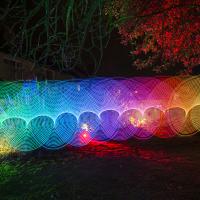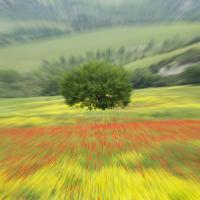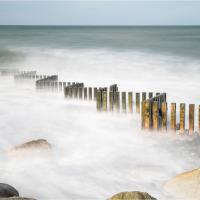There was no meeting for the IOM Photographic Society again this week, so my topic is long exposure photography, a subject that can be practised at home.. Most of us take our images with the auto setting on our cameras which basically allows the camera and the sophisticated algorithms therein to make all the decisions as to the aperture and speed at which our images are taken and on the whole, our images will turn out pretty well, sharp in the area we focussed on, reasonably exposed and capturing the moment.
However, there are circumstances when much longer exposures will be necessary as in darkness (for astrophotography for example, when the stars provide only very faint light for the image), or when the photographer wishes to show movement as part of the image, as with fireworks or light trails, as seen in the garden image by Sue Jones, or even a genre known as ICM Intentional Camera Movement where the camera is moved during the exposure to produce the image, though always with unpredictable if artistic results. The Tuscan poppy field image by Sue Blythe, also seen here, is an image shot with a telephoto lens, the lens zoomed during the exposure to blur the image, only the centre staying more or less identifiable.
Another obvious example is a waterfall. A fast shutter speed will freeze the movement of the water so every droplet is seen, a slightly slower shutter will give the water a streaky effect, whilst a very slow shutter will result in an almost cloud-like milky effect. So how the image turns out is entirely in the control of the photographer and the settings used.
For slow shutter speeds, a tripod is always a useful part of ones kit, whilst there are a range of neutral density filters (the term neutral implies the filter should not result in any colour cast in the final image though this is not always the case). Filters are square or round pieces of glass or plastic usually put in front of the lens which limit the amount of light entering the lens andenable slower shutter speeds to be used. These can be graduated (partly clear and partly darkened) or solid, and both come in a range of densities from a little darkening and a modest effect to almost totally black and resulting in a major slowing to the shutter speed. Some solid ND filters are particularly popular the little stopper reducing the light entering the lens by 6x, the big stopper by 10x, and the super stopper by 15x. So a normal shot taken at 1/250th of a second becomes a 4 second exposure with a big stopper, and 2 minutes with a super stopper and enabling some very creative effects for ones images.
The image here shown of the groynes at Glen Mooar used a big stopper to reduce the amount of light by 10 times and to obtain the cloudy water effect seen.
Given the current Covid-19 situation, our programme is in abeyance and we are unable to provide a date for our next meeting, so please check our website www.iomps.com or our Facebook page for details of any updates or changes. Our meetings are held the St John Ambulance HQ on Glencrutchery Road, starting at 7:00 pm and are open to the public (non-members with a modest entry fee), and all will be given a very warm welcome.
The Isle of Man Photographic Society is supported by the Arts Council
Chris Blyth
CAPTIONS:
IMAGE 01: 'Garden Colours' by Sue Jones
IMAGE 02: 'Tuscan Poppy Field' by Sue Blythe
IMAGE 03: 'Glen Mooar' by Chris Blyth



